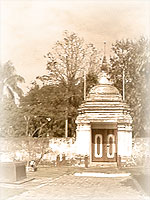Wat
Ku Kam or Wat Chedi Liam
|
|
Formerly known as Koo Kam Temple, King Mengrai built a stupa
contained the relics of his wife who die aroun 1294 B.E at
Wiang Kum Kam. This square stepped stupa is a replication
of Chammadevi Stupa in Lumphun with 15 arched niches for Buddha
images on each side. It was renovated in 1908 B.E by a wealthy
Burmese who modified the arched niches and floral designs
with Burmese architecture. However, the square stepped stupa
remained intact. The Fine Arts Department restored and conserved
this stupa once again in 1995-1996 A.D.
|

|
|
 |
|
Wiang Kum Kam
The Underground Empire
The most ancient evidence to have mentioned Wiang
Kum Kam is the stone inscription of Wat
Phra Yuen, Lamphun, which was inscribed in the Sukhothai
Thai letters in 1370 A.D. The Word “Kum
Kam” appears in Line 31 on Side 1 of the inscription.
“Kum Kam” has been defined as ‘protection
of the land’. The same definition for the town’s name
is also explained in a poem as ‘Khlong Nirat Hairphunchai’
or ‘Travel to Hariphunchai’.
Wiang Kum Kam
is now over 700 years old and a site of ancient civilization
on the Ping River basin.
|
|

